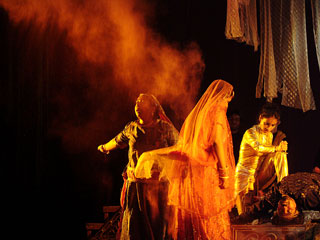Our Production
PATH THE WATERFALL
Play :Rabindra Nath Tagore
Direction :Debasish Dutta
Light :Jayanta Mukhopadhay
Music :Krishanu Banerjee
The Waterfall was first published in 1922, the same year as its Bengali original, Muktadhara (Free Current). Tagore admittedly chose the title inspired by the Pagla-jhora or the Mad Stream the waterfall at Darjeeling. It is considered by many as one of the finest plays written by Tagore. The play in Tagore’s own words “is a representation of concrete psychology”. Abhijit, one of the principal characters, after a revelation of his castaway status, develops a belief that he has a spiritual relationship with the waterfall beside whose mouth he was discovered. He is convinced that he has a message to conve6y to the world to open out ‘PATH’s for the adventurous spirit of man. This self realization leads him to emancipate not only the prisoned waters of Muktadhara but also his own life from the shackles of the palace and its responsibilities.
HORIKHELA ... A FESTIVAL OF COLORS
Play :Rabindra Nath Tagore
Direction :Debasish Dutta
Light :Jayanta Mukhopadhay
Music :Krishanu Banerjee
‘Bhunag’ is a small piece of land of India. It was an independent reign of the local King. But the King was idle. He was drowned in love with his queen. He was a feeble administrator and used to spend his time in pleasure and merry making. His queen was a lady of vibrant personality. Though she loved her husband but disliked the King’s idealistic approach.
Suddenly a Pathan Warmonger Keshar Khan attacked their land. The king wished to have a treaty with Keshar Khan without any conflict or prevention. But the queen was not ready to surrender. She rebuked the king rudely and made the king fight for the country and freedom. The king was killed.
Every one thinks that the war ended. Suddenly Keshar Khan gets an invitation from queen for visiting ‘Bhunag’. The queen had shown interest to meet the Pathan king for ‘Horikhela’ (a festival of colors).
Keshar khan goes there with only some body guards. Rajpoot fighters come in disguise as the pretty companions of the queen in the party. The beauty of the queen overwhelms
Then the assassination takes place. By killing Keshar Khan the queen quenches her thirst of vengeance.
The dialogue of the story is lyrical. Poems of the great poets of Bengal have been used in stand of normal conversations. Designed Music and Choreography, compositions with energy flow, acrobatic to translate sequences is to the language of theatre.
The production is a tribute to the collective work of the immortal creations of different Bengali well known poets.
RAJA... the king of the dark chamber
Play :Rabindra Nath Tagore
Direction :Debasish Dutta
Light :Jayanta Mukhopadhay
Music :Krishanu Banerjee
RAJA…. The king of the dark chamber, written in 1910, is perhaps the most mysterious and subtle of Rabindranath’s symbolical plays. A certain strange and weird beauty pervades the whole story and a sense of mystical remoteness grows upon the mind as the play slowly advances to its conclusion. It starts with the idle gossip of a handful of citizens and wayfarers about the identity of the King develops into strife, and when we reach the conclusion, we find ourselves even more deeply involved in the curiosity and mystery which started us on the search.
Raja is one of the great conceptual texts of Tagore. In this story we cannot have a view of ‘Raja’. The central character ‘Raja’ always confines himself in a dark room. Everybody only can have the voice of Raja and never gets a view of him. ‘Raja’, the king looks awesomely bad and he has a clear knowledge of his odd looks. But he is a great human being with high moral and holly heart.
The text always hammers us about the fact that, physical beauty does not carry any great aspects of life; but the actual beauty of a man lives in his inner soul; which is important for entire mankind to hold the social values, moralities at a high level.












